Korean Mountainash, Sorbus alnifolia
“…No two trees are the same to Raven.
No two branches are the same to Wren.
If what a tree or bush does is lost on you,
You are surely lost…”
-David Wagoner
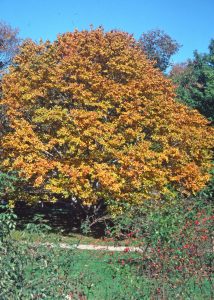 Who among us does not stand momentarily in awe for what certain trees or shrubs do, especially this time of year. The Korean Mountainash, Sorbus alnifolia is a tree to be praised during all seasons, but its autumn display must take first place during comparisons of its own seasonal ornamental attractiveness. Many an October to early-November at Mount Auburn, is enhanced with yellow fall foliage from our diverse natural cornucopia, which includes sugar maple, ginkgo, birch, linden, hickory, redbud, witch hazel, tulip tree, even ferns, amongst many others. None of these autumn joys also couple their golden hues with contrasting bright, red or pinkish, fruits as do our Korean Mountainash. In a good year, their vivid combination of colors could help to win it a place in the running for most striking tree in the fall landscape.
Who among us does not stand momentarily in awe for what certain trees or shrubs do, especially this time of year. The Korean Mountainash, Sorbus alnifolia is a tree to be praised during all seasons, but its autumn display must take first place during comparisons of its own seasonal ornamental attractiveness. Many an October to early-November at Mount Auburn, is enhanced with yellow fall foliage from our diverse natural cornucopia, which includes sugar maple, ginkgo, birch, linden, hickory, redbud, witch hazel, tulip tree, even ferns, amongst many others. None of these autumn joys also couple their golden hues with contrasting bright, red or pinkish, fruits as do our Korean Mountainash. In a good year, their vivid combination of colors could help to win it a place in the running for most striking tree in the fall landscape.
 These days there might be some that hope to hear any reference to Korea without dark foreboding associated with it. A brief review of historic Korea (North and South together) reveals a small area with about 85,000 square-miles, a size just smaller than Minnesota, or of both Virginia and Tennessee combined. Bordering the far northeastern region of China, its geography includes a peninsula projecting southerly, opposite Japan to its east, both separated by the Sea of Japan. The prehistory of Korea indicates hominid fossils of at least 100,000-years. In its last millennia, the area has an evolved history including being under spheres of influence of both China and Japan. At the end of World War II, with the surrender of Japanese forces, the country was partitioned with the Soviet Union and United States occupying the North and South respectively. This division eventually led to the Korean War in 1950, which although ended in 1953, has resulted in the two separate countries being hostilely antagonistic and competing ever since.
These days there might be some that hope to hear any reference to Korea without dark foreboding associated with it. A brief review of historic Korea (North and South together) reveals a small area with about 85,000 square-miles, a size just smaller than Minnesota, or of both Virginia and Tennessee combined. Bordering the far northeastern region of China, its geography includes a peninsula projecting southerly, opposite Japan to its east, both separated by the Sea of Japan. The prehistory of Korea indicates hominid fossils of at least 100,000-years. In its last millennia, the area has an evolved history including being under spheres of influence of both China and Japan. At the end of World War II, with the surrender of Japanese forces, the country was partitioned with the Soviet Union and United States occupying the North and South respectively. This division eventually led to the Korean War in 1950, which although ended in 1953, has resulted in the two separate countries being hostilely antagonistic and competing ever since.
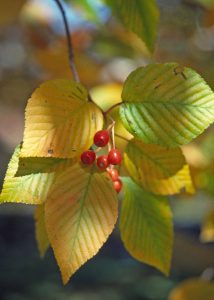 Korean Mountainash, Sorbus alnifolia was introduced to the west during a less fractious (for Korea) second-half of the 19th-Century, as plant collectors from non-Asian countries first gained access and collected from the Korean native flora. This is a tree that will grow to 40-50-feet in height. The leaves are alternate, simple (many other species of mountain ash leaves are compound), two-four-inches long, with a distinct serrated margin, and a lustrous green color, until the autumn yellow to golden brown.
Korean Mountainash, Sorbus alnifolia was introduced to the west during a less fractious (for Korea) second-half of the 19th-Century, as plant collectors from non-Asian countries first gained access and collected from the Korean native flora. This is a tree that will grow to 40-50-feet in height. The leaves are alternate, simple (many other species of mountain ash leaves are compound), two-four-inches long, with a distinct serrated margin, and a lustrous green color, until the autumn yellow to golden brown.
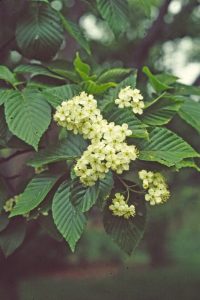 White ½-inch flowers in flat-topped clusters (corymbs) occur in May, more prolifically in alternate years. It is when these flowers are successfully fertilized that the ½-inch, roundish, red to pinkish-red pome are produced. The autumn juxtaposition of these colorful fruits with fall leaves provide a notable spectacle. However even after all the leaves have fallen away, these colorful fruits persist on the bare branches providing later fall interest. Some of these red fruits, in decreasing numbers, persist on the tree into early winter, often providing bright contrast when there is snow on the ground.
White ½-inch flowers in flat-topped clusters (corymbs) occur in May, more prolifically in alternate years. It is when these flowers are successfully fertilized that the ½-inch, roundish, red to pinkish-red pome are produced. The autumn juxtaposition of these colorful fruits with fall leaves provide a notable spectacle. However even after all the leaves have fallen away, these colorful fruits persist on the bare branches providing later fall interest. Some of these red fruits, in decreasing numbers, persist on the tree into early winter, often providing bright contrast when there is snow on the ground.
On an autumn visit, or anytime, to Mount Auburn look for our Korean Mountainash, Sorbus alnifolia on Garden Avenue, Pond road, Elder Path and Curfew path among other locations.
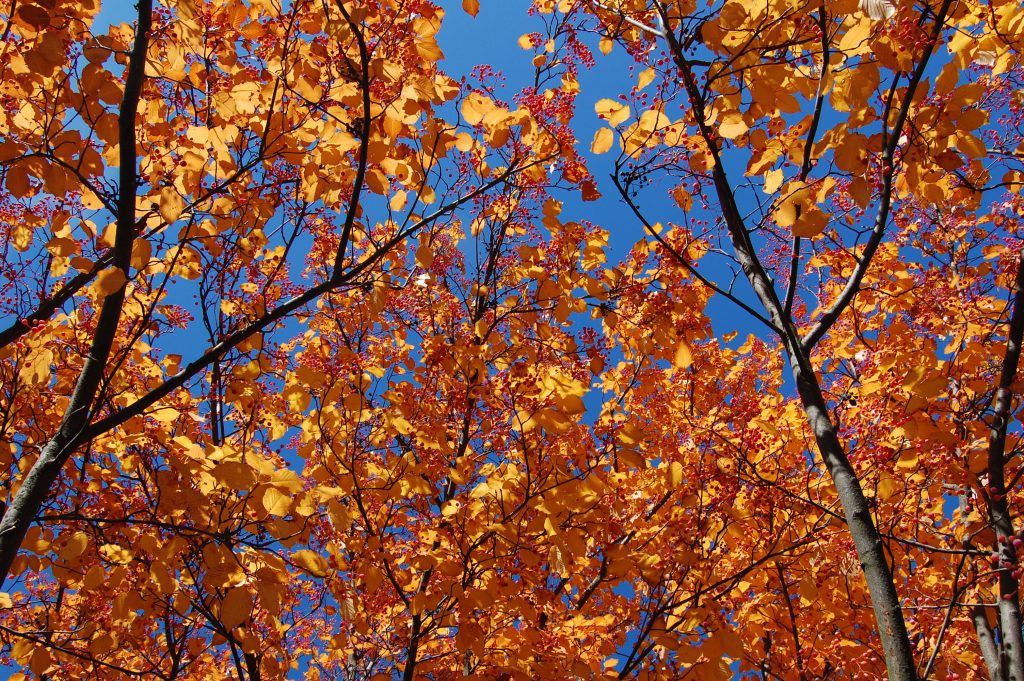
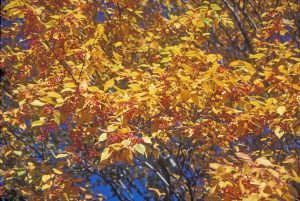
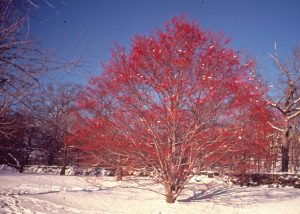
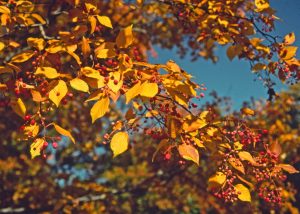
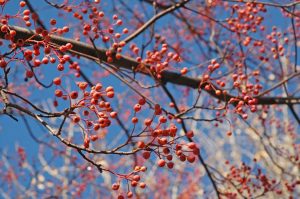
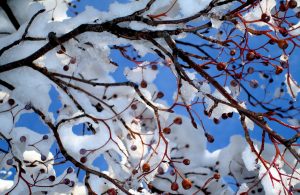
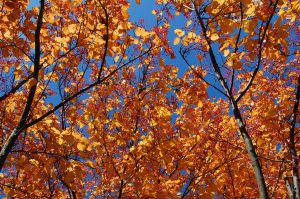

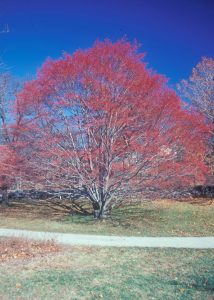

Leave a Reply to Rev Dr Tom Jones Cancel reply